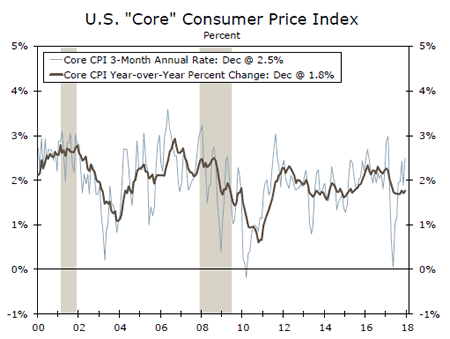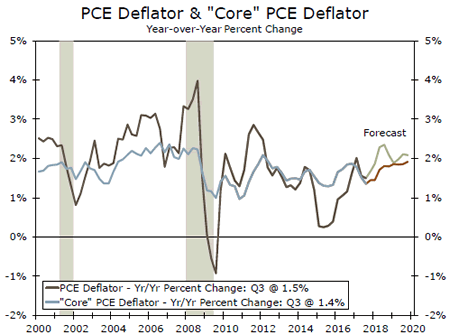U.S. Review
Higher Retail Sales, Budget Deficits and Treasury Yields
- Data released on Thursday showed the federal budget deficit was $23.2 billion in December and $225 billion through the first three months of federal fiscal year 2018 as concerns grew regarding a potential surge in Treasury issuance.
- The consumer price index met expectations for headline growth, up 0.1 percent in December, and topped expectations for the core index, which rose 0.3 percent.
- Retail sales growth posted another solid reading in December, suggesting a healthy contribution to GDP growth in Q4 from U.S. consumers.
Higher Retail Sales, Budget Deficits and Treasury Yields
The Job Openings and Labor Turnover Survey (JOLTS), import price index and producer price index all came in a bit on the soft side in the first few days of the week. Job openings edged down for a second straight month in November, a respite from the sharp run-up over the first three-quarters of 2017. Openings are up 4.4 percent over the past year, but that marks a slowdown from earlier and, if sustained, suggests a more moderate pace of hiring ahead. Though progress has been painfully slow, the quit rate has slowly grinded higher, suggesting improved worker confidence in the labor market (top chart).
On the inflation front, import prices rose 0.1 percent in December, lifted by a 1.8 percent increase in fuel prices. Non-fuel prices were soft, however, falling 0.1 percent in the month, but still managed to increase 1.0 percent in 2017, the largest annual gain since 2011. The headline producer price index (PPI) unexpectedly fell in the month, and core measures of the index were softer-than-expected across the board. Despite a depreciating trend for the dollar and robust survey/production data for U.S. firms, the December import price index and PPI showed few signs of imminent price pressures from these sources.
Data released on Thursday showed the federal budget was $23.2 billion in December and $225 billion through the first three months of federal fiscal year 2018. Earlier this week, U.S. Treasury yields jumped at the long-end of the curve as concerns arose about a surge in Treasury issuance on the horizon. Since September, we have been nearly $200 billion above the Congressional Budget Office’s FY 2018 budget deficit forecast. This expected surge in net Treasury issuance can be attributed to three main factors 1) bigger deficits from the tax cuts, 2) greater spending across the board (our expectation that there will be higher budget caps for defense/non-defense spending in addition to the multiple bills for disaster aid related to the hurricanes and California fires) and 3) a backlog of debt to be issued as a result of the Treasury being up against the debt ceiling for much of 2017.
The consumer price index (CPI) met expectations for headline growth, up 0.1 percent in December, and topped expectations for the core index, which rose 0.3 percent. On a year-over-year basis, headline CPI is up 2.1 percent and the core has risen 1.8 percent. Though this was higher relative to the Bloomberg consensus, the core CPI has hovered between 1.7 percent and 1.9 percent every month since March, a stable string of readings that suggests a continued gradual pace of monetary policy tightening by the FOMC.
Retail sales rose 0.4 percent in December, boosted by stronger sales from non-store retailers, building material retailers and food service places. Control group sales, which excludes food, gas, building materials and autos and feeds directly into the consumption line of GDP, rose 0.3 percent in December and November was upwardly revised to a robust 1.4 percent reading. Together, this brings the three-month average annualized rate to 8.9 percent, the fastest pace of growth since September 2003.
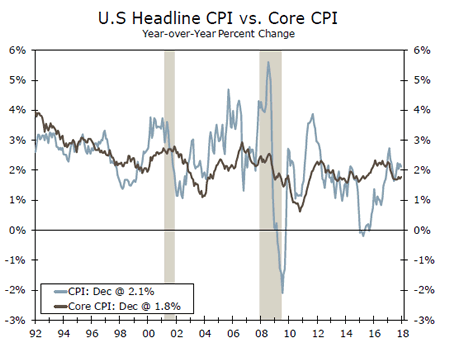
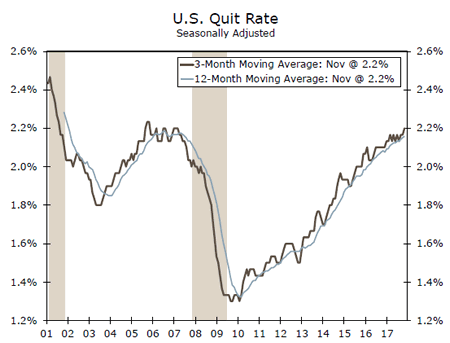
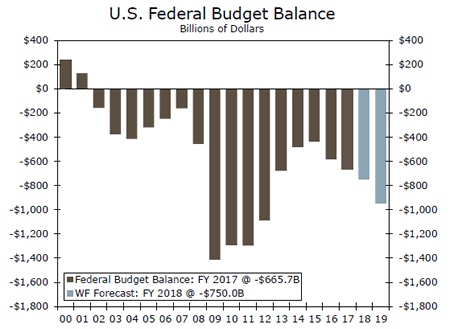
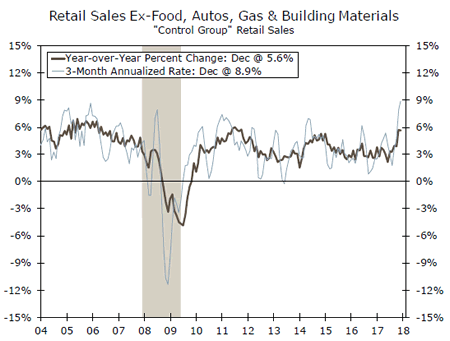
U.S. Outlook
Industrial Production • Wednesday
Industrial production edged up 0.2 percent over the month in November, falling slightly short of expectations of a 0.3 percent gain. However, the report brought a positive surprise in an upward revision of October’s initially reported 0.9 percent gain to 1.2 percent. Manufacturing produces roughly three quarters of industrial production, and posted a slight positive gain to follow up October’s strong jump. Utilities production, on the other hand, fell by nearly 2 percent, as 2017 gave us the seventh warmest November in history. Mining output posted its eighth monthly increase of the year in November.
While industrial production has shown modest growth, capacity utilization has been relatively weak. This measure has room to run, and combined high business confidence, a relatively weaker dollar and recently passed tax cuts, we could see industrial production firm even further as we move into 2018.
Previous: 0.2% Wells Fargo: 0.4% Consensus: 0.4% (Month-over-Month)
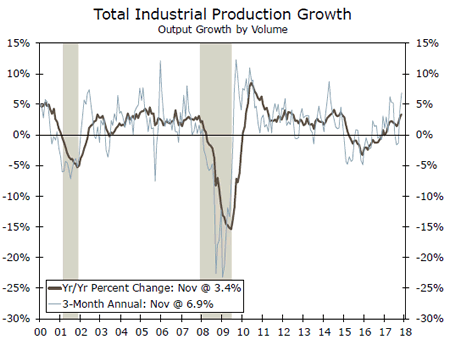
NAHB Housing Market Index • Wednesday
December’s NAHB/Wells Fargo Housing Market Index was one for the record books, rising five points to 74 and posting the highest level since 1999. This historic confidence indicates that homebuilders are eager to ramp up production, as long as they can find the lots and workers to do so. All three components of the index increased in December, led by an eight point gain in buyer traffic. Growing buyer demand has been stoked by strengthening employment and income growth, as well as soaring consumer confidence. The low level of available for-sale inventory has created fierce competition among buyers, and that should only ramp up as demand gains more momentum.
Builders have been selling homes about as quickly as they can build them. Our outlook is that buyer traffic will continue to build into 2018, keeping builder confidence high while enjoying the insatiable buyer demand.
Previous: 74 Consensus: 72
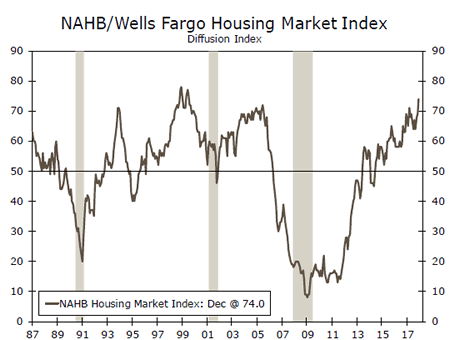
Housing Starts • Thursday
Single-family housing construction reached a cycle-high pace of a seasonally adjusted annualized 930,000 units in November. Results were mixed geographically. Starts in the South and West, the two largest regions for home construction, increased, while the Midwest and Northeast declined. Revisions from this summer’s hurricanes pushed a significant portion of building activity into November, which is a primary reason for the cycle-high reading. However, the trend is definitively positive given solid readings in both October and November, and we expect December to continue the trend.
We expect residential investment to continue ramping up across the country, providing a significant boost to Q4-2017 GDP as well as in 2018.
Previous: 1,297K Wells Fargo: 1,280K Consensus: 1,270K
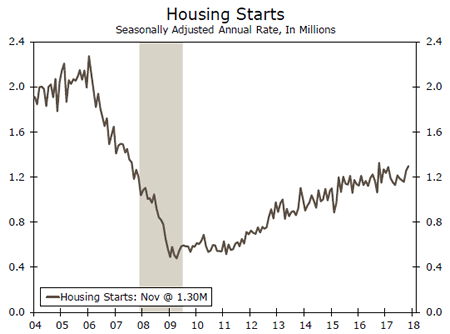
Global Review
Strong Q4 Economic Data in Europe
- Measures of business confidence have been overstating the strength of the Eurozone economy in 2017, but the disconnect between the "soft" and the "hard" data may be starting to narrow as industrial production in the Eurozone grew strongly in November.
- Incoming data suggest that real GDP growth in the United Kingdom was solid in Q4.
Brazilian Economy Continues To Pick Up Steam
- The volume of Brazilian retail spending rose much more than expected in November.
Strong "Hard" Data in Eurozone in Q4
A curiosity of the current economic expansion in the Eurozone has been the disconnect between "soft" and "hard" economic data. For example, the Ifo index of German business sentiment, which historically had a high degree of correlation with growth in German industrial production (IP), has soared to record highs in recent months (see chart on front page). Yet, growth in IP has remained disappointing, at least in a historic context.
Perhaps that disconnect is starting to narrow. Data released this week showed that German IP jumped 3.4 percent in November relative to the previous month. On a year-ago basis, IP was up 5.6 percent in November, the strongest growth rate in six years. German statistical authorities also announced that preliminary estimates show that real GDP grew 2.2 percent in 2017. If confirmed by the more complete data that are scheduled for release next month, 2017 will have been the strongest year for German GDP growth since 2011.
Data released this week by other countries in the euro area were generally strong as well. IP in the overall Eurozone grew 1.0 percent in November, which followed the 0.4 percent rise in October. Retail spending in the euro area was up 1.5 percent in November relative to the previous month. The monthly data give us more confidence that our estimate for real GDP growth in the fourth quarter (0.6 percent sequentially, 2.5 percent year over year) is realistic (top chart).
U.K. Economic Data Also Solid
Across the English Channel, economic data out of the United Kingdom also were generally solid this week. British IP rose 0.4 percent in November relative to the previous month, and survey data suggest that retail spending rose solidly in December. However, the real trade deficit appears to have widened in the fourth quarter, which likely exerted some headwinds on Q4 GDP growth. That said, a well-respected British think tank announced that it estimates that real GDP grew 0.6 percent (not annualized) on a sequential basis in Q4. If realized, it would be the strongest rate of sequential growth for the U.K. economy in 2017.
Brazil Continues To Surprise On the Upside
The Brazilian economy suffered a deep recession in 2015-2016, but it is growing again. Data released this week showed that the volume of retail sales rose 5.9 percent in November on a year-ago basis, which was significantly stronger than most analysts had expected. The outturn gives us more confidence that our forecast of strengthening growth on a year-over-year basis in coming quarters is reasonably on track (bottom chart). Although a measure of consumer price inflation rate edged up from 2.8 percent in November to 3.0 percent in December, it remains well below the 10 percent rate that was registered in late 2015/early 2016. Not only has the sharp fall in inflation allowed the central bank to slash interest rates, which has helped to support growth, but it has shored up real income, which is leading to the stronger growth in consumer spending which was noted previously.
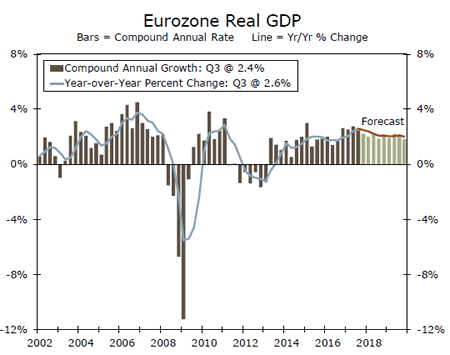
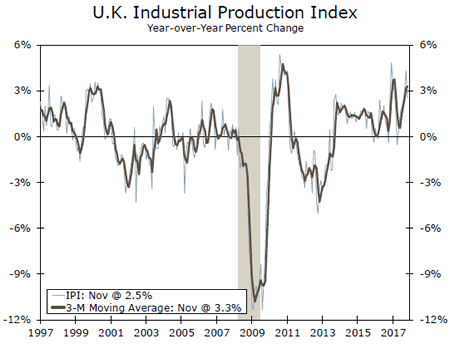
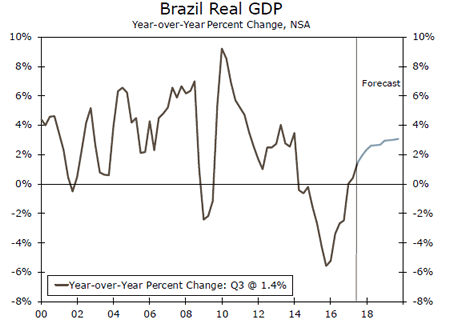
Global Outlook
Brazil Economic Activity • Monday
Although the Brazilian political system lacks clarity, especially this year as the presidential election approaches, the Brazilian economy has finally been able to untangle itself from all the problems that remain and has started to grow, albeit from a very slow base. On Monday, markets will be able to take a look at whether this improvement continued in the fourth quarter of 2017 by taking a look at the monthly economic activity index, a monthly proxy for GDP, for November. The index has been relatively volatile month over month but positive for September and October. Thus, a positive reading in November will add to the already upbeat expectations that the economy has turned the corner for good. The year-over-year rate, which was 2.9 percent in October, was the strongest since February 2014, so a strong showing by this rate would also cement a sense of continuous improvement in economic growth.
Previous: 2.9% Consensus: 2.5% (Year-over-Year)
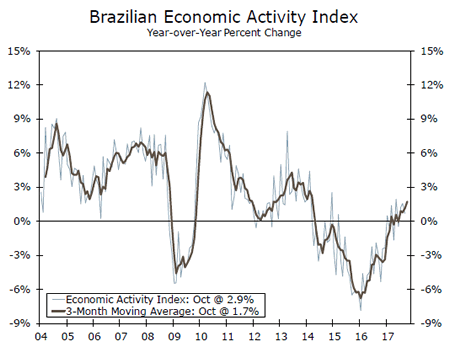
Bank of Canada Interest Rate • Wednesday
North America came out of the gates early in this latest global tightening cycle with the U.S. Federal Reserve, the Bank of Canada and the Bank of Mexico leading the way in terms of higher interest rates. While one of the reasons has to do with the geographic proximity to the United States of both Canada and Mexico, other reasons are fundamentally domestic.
In this sense, we expect the Bank of Canada to continue with its own tightening campaign by increasing its target rate 25 bps, to 1.25 percent on Wednesday. The recent employment report and the uptick in CPI inflation lifted the odds of an increase. This follows a 25 bps increase in July and another one in September of last year. Going forward, we expect the Bank of Canada to continue to follow the events south of the border and decide on further moves according to its policy needs.
Previous: 1.00% Wells Fargo: 1.25% Consensus: 1.25%
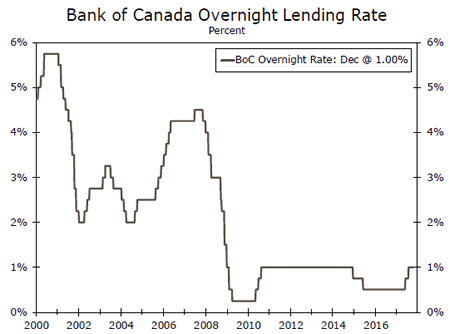
China Q4 GDP • Thursday
Next week will end with the release of Chinese Q4 GDP growth. Markets are looking at more of the same from Chinese GDP growth, expecting a growth rate of 6.7 percent compared to a 6.8 percent rate during the previous year. On a quarter-over-quarter basis, markets expect a growth rate of 1.7 percent, not annualized, similar to the previous quarter.
Also on Thursday, we will get both retail sales and industrial production for December. Markets are expecting retail sales to have ended the year up 10.2 percent, unchanged from the previous month, year over year. Meanwhile, industrial production is expected to come in at 6.1 percent in December, also unchanged from the November reading. Thus, markets expect no surprises coming from the second-largest economy of the world, which will probably be good news for the global economy.
Previous: 6.8% Wells Fargo: 6.7% Consensus: 6.7% (Year-over-Year)
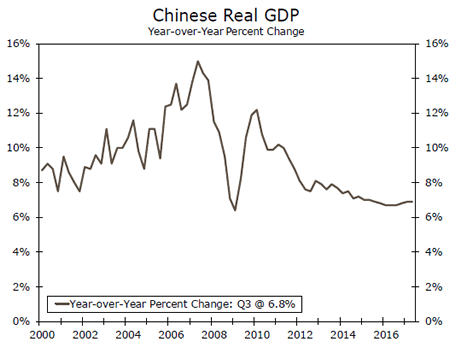
Point of View
Interest Rate Watch
Evolution of the Outlook
Looking into 2018, our outlook was for three Fed funds rate increases (March, June and September) based upon the evolution of the inflation rate over this period. But at the intermediate and long-end of the Treasury yield curve, the rise in rates would also reflect the funds rate increases but with a significant degree of uncertainty, and added volatility, as the Fed attempts to reduce its balance sheet while the U.S. Treasury increases debt issuance and deficit projections rise.
Inflation: FOMC Follows Its Model
For the FOMC, the increase in the PCE deflator projected in our annual outlook should be sufficient to justify the FOMC rate increases in both March and June of this year. We project the PCE deflator to hit 2.3 percent by the second quarter of this year. After three years of below target (2 percent) inflation the wait will be over. Yes, it is easy to be skeptical that inflation will hit the 2 percent target but we are now seeing stronger final demand and an unemployment rate below 4 percent by midyear.
Reducing the Balance Sheet
Balance sheet reduction is a second tool for the FOMC to normalize interest rates (middle graph). Our view is that this reduction will be painless in the first half of 2018 but by the third quarter, the reductions will mean actual net redemptions of Treasury debt—particularly in the three, five and seven year maturity range. Effectively this is a reduction in the demand for Treasury debt by one of the three big buyers of Treasury debt—the Fed, China and Japan.
But Supply? Rising
Looking forward, the supply of Treasury debt is expected to rise steadily for the next two years. The conflict between reductions in Fed demand and rising Treasury issuance presents a challenge to investors for the second half of this year. Already we have witnessed an increase in two-, three-, five-, seven- and 10-year yields above what was expected in the market just one month ago. We began the year with an above consensus 10-year rate forecast, a good start for the outlook.
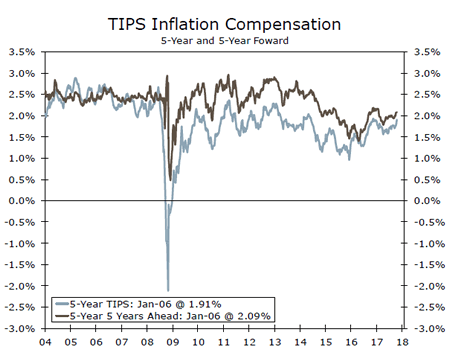
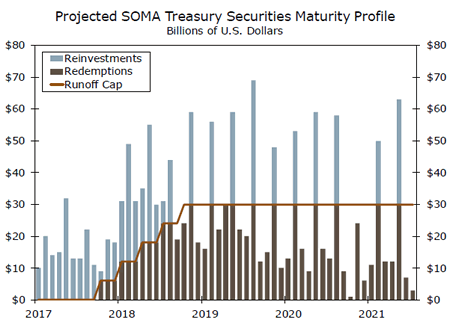
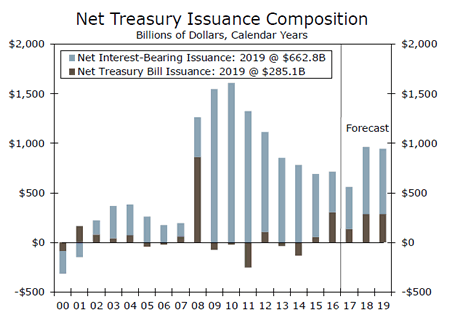
Credit Market Insights
Cycle High Consumer Credit
Consumer credit grew nearly $28 billion in November, registering the largest monthly gain in 16 years. This large increase in new debt is an indication of continued confidence in the economy, as buyers appear increasingly willing to borrow to fund consumption habits. Despite slowing slightly in December, consumer confidence hit a 17-year high in November.
Revolving credit, mostly credit card debt, rose $11.2 billion, or 13.3 percent. This increase caused total outstanding revolving credit to not only surpass pre-recession highs, but reach a fresh series high of about $1.0 trillion. The surge in credit card balances in November is yet another sign of increased spending during the holiday season.
Similarly, nonrevolving credit, which is mostly made up of student and auto loans, rose 16.8 billion, or by 7.2 percent. Nonrevolving credit was somewhat driven by increased auto loans, still partially attributable to effects from storm related damages.
With the holidays now behind us, and hurricane replaced buying surely fading away, will elevated levels of borrowing continue? We expect continued confidence and tight labor conditions to continue to drive consumer credit in the near future, but remain cautious of a slowing in borrowing as the economic cycle continues to mature.
Topic of the Week
Peak Inflation?
A sharp slowdown in inflation last spring was one of the big surprises of 2017. After finally reaching the Fed’s 2 percent target last January, inflation, measured by the PCE deflator, slowed to 1.5 percent by the third quarter. This year, however, we expect to see a meaningful pickup in inflation in the middle of the year, at least when measured by the conventional year-ago basis.
Last year’s surprise weakening can be largely traced to a couple of categories. The cost of wireless phone services fell 7.0 percent in March alone, leading to a rare monthly decline in core inflation. Also last spring, inflation for shelter and physician services slowed markedly. The trend among all three categories has strengthened in recent months, pushing core CPI when measured on a three-month annualized basis up to 2.5 percent. Unless core inflation declines again this spring, base effects are set to lead to a noticeable pickup in core and, consequently, headline, inflation when measured from a year ago by the middle of the year.
The higher trajectory is unlikely to persist, however. We expect the year-over-year rate of inflation to peak around mid-year. Core inflation is likely to continue to drift higher as the economy strengthens, but the pickup will be gradual as inflation expectations remain historically low and fierce price competition persists.
At the same time, the lift to headline inflation from higher energy prices is set to fade. Oil prices were up more than 10 percent in the fourth quarter compared to the prior year, but such large percentage gains will be tougher to achieve as the market becomes more balanced. We expect energy to be a small drag on headline inflation in the second half the year as oil prices fall below current levels.
With the expected moderation in the second half of this year stemming from the volatile energy sector and tougher base comparisons for the core index, we suspect it will not get in the way of further Fed rate hikes this year. That said, with inflation just around 2.0 percent, tightening should remain slow.
